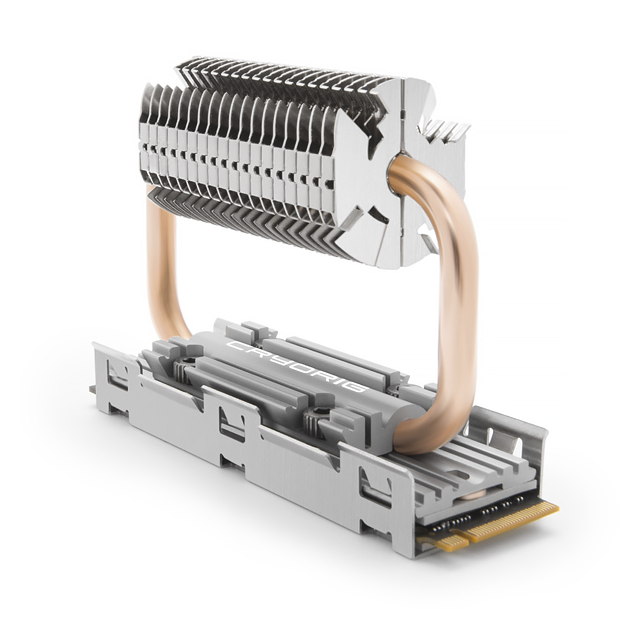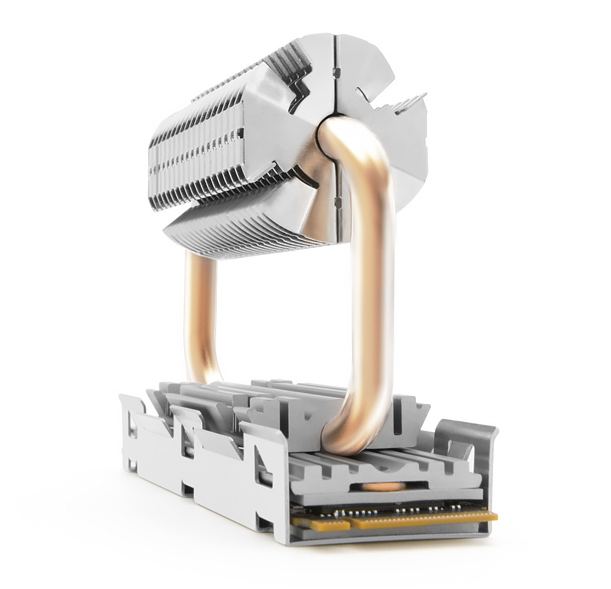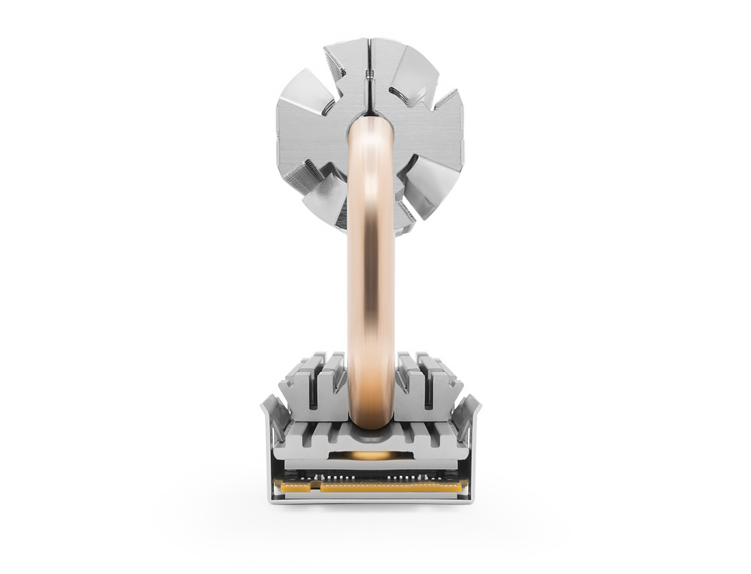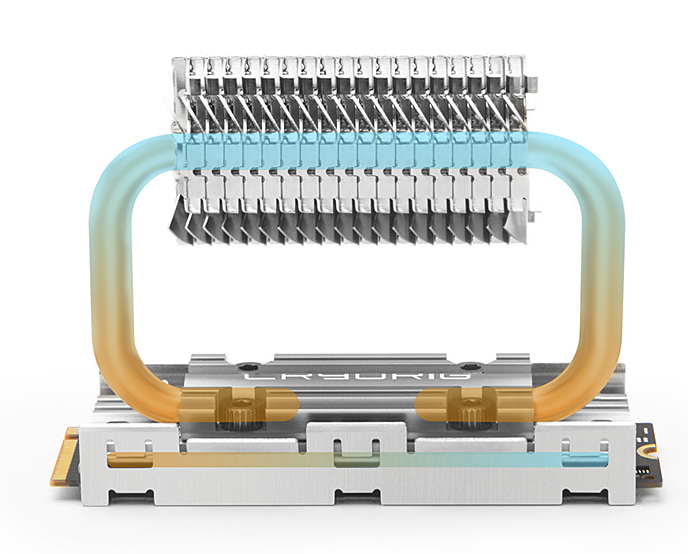Cryorig Unveils Frostbit M.2 SSD Cooler With Dual Heatpipes
SSD throttling got you down? If so, Cryorig has you covered with its new Frostbit M.2 SSD cooler that it will introduce at Computex. The company claims the passive cooler is the industry's first dual heatpipe cooler for M.2 SSDs.
Even garden-variety SSDs have thermal throttling mechanisms that reduce performance during use to keep your SSD healthy–particularly the SSD controller. Unfortunately, these throttling mechanisms can engage and disengage rapidly, so it can be hard to detect. Throttling definitely has an impact on SSD performance, specifically during extended tasks, like large file transfers.
Many new M.2 SSDs come with either affixed or optional heatsinks to dissipate waste heat, but those models are usually more expensive. Some tricked-out motherboards also come with built-in M.2 SSD coolers, which also helps. If you have a cheaper motherboard or an M.2 SSD that comes without an integrated heatspreader, the Cryorig Frostbit might be a good solution.
The Frostbit design features an "Ultra Thin" heatpipe embedded in the base of the cooler, which helps distribute heat from the M.2 SSD components evenly. The larger 6mm heatpipe pulls the heat into the passive radiator, which sports 38 fins, from both ends of the smaller heatsink.






It doesn't help if you have a fire-breathing GPU right on top of your M.2 SSD, and that's usually the case. Unfortunately, many M.2 SSD slots are positioned between PCIe slots on the motherboard, which means they tend to be buried under the GPU. That also makes it difficult to attach a bulky passive cooler, or one of the more exotic waterblocks we've seen for SSDs.
Cryorig addresses the problem by allowing you to adjust the cooler and offset it from the GPU, as seen in the graphic.
The heatsink is rather small, measuring 72 x 27.3 x 57mm. You'll notice the 72mm length doesn't entirely cover a standard M.2 2280 form factor SSD, which is 80mm long. Instead, the cooler is designed to cover just the components on the SSDs' PCB and not interfere with the mounting screw or interface, which are on the opposing ends. Of course, this means the cooler wouldn't be effective with longer SSDs.
Get Tom's Hardware's best news and in-depth reviews, straight to your inbox.
The passive cooler, which weighs 56g, can dissipate up to 12W, which is far beyond what you will find with a typical M.2 SSD.
Cryorig hasn't shared pricing or a release date yet, but we should learn more at the looming Computex.

Paul Alcorn is the Editor-in-Chief for Tom's Hardware US. He also writes news and reviews on CPUs, storage, and enterprise hardware.
-
stdragon Reply20994360 said:If this is under $45 I don't think I will be able to resist buying it.
Even if it provided no technical value, the fact it looks cool (pun intended) might be reason enough to get it :D -
Zaporro What is that thing with M.2 SSD thermal throttling? Is this a new scheme for hardware companies to sell "Gamers" obsolete stuff just to milk them from cash?Reply
My Samsung EVO 960 500GB without any heatsink can reach 80 Celsius degrees during extensive benchmarking and still maintain full speeds and do not fall into thermal throttling.
It seems that some one singular case where early design M.2 NVMe SSD throttled speed due to temperature (and possibly bad case airflow) caused shitpost media to blow the issue out of proportion and then open up an avenue for hardware manufacturers to sell something that in reality is not needed.
RGB M.2 heatsinks will be pinnacle of that where people will stat buying them "because i heard it helps".... -
ElectrO_90 I just wish they made all M2 slots vertical, then we wouldn't have to suffer with the heat problems and the annoyance of the M2 being under the GPU! I mean seriously, who would recommend putting it there?Reply -
redgarl This is totally useless. If that was necessary, SSD manufacturer would have developed a solution and made it accessible to the public.Reply
This is nothing more than some bling bling. -
Lutfij Reminds me of the Thermaltake Spin Q CPU cooler and all the other aftermarket heatsinks back in the day when they were fancy :DReply -
Paul Alcorn Reply20995776 said:What is that thing with M.2 SSD thermal throttling? Is this a new scheme for hardware companies to sell "Gamers" obsolete stuff just to milk them from cash?
My Samsung EVO 960 500GB without any heatsink can reach 80 Celsius degrees during extensive benchmarking and still maintain full speeds and do not fall into thermal throttling.
It seems that some one singular case where early design M.2 NVMe SSD throttled speed due to temperature (and possibly bad case airflow) caused shitpost media to blow the issue out of proportion and then open up an avenue for hardware manufacturers to sell something that in reality is not needed.
RGB M.2 heatsinks will be pinnacle of that where people will stat buying them "because i heard it helps"....
You may not realize it, but Samsung's SSDs do throttle and the company even quantifies how much data the SSD can transfer before it engages. From our review of that model --
Samsung attacked thermal throttling from several angles. The Polaris controller runs cool during general desktop use, but it has a high thermal ceiling. Samsung highlights the thin copper strip that it embedded in the 960 EVO's label, but we have our doubts about its effectiveness. For what it is worth, there is a thin copper strip between the adhesive layers and printed layer on the label. The company placed several copper layers under the black paint, and the printed circuit board also features a larger, thicker copper layer that is in closer proximity to the heat source.
Throttling seems to occur in stages to minimize the impact on the user experience. The 960 EVO can operate a full 16 seconds longer than the 950 Pro before the dynamic thermal guard (DTG) triggers and reduces performance to maintain a safe thermal envelope. That allows 60% more data to transfer, which is a full 253GB of data during sequential reads on 512GB-class products.
The throttling can be brief, it typically occurs in spurts (micro-throttling) to reduce the observable impact. That said, if you can transfer 253GB of data before the throttling kicks in, a heatsink really isn't necessary. It is cool, though.
-
Paul Alcorn Reply20995802 said:This is totally useless. If that was necessary, SSD manufacturer would have developed a solution and made it accessible to the public.
This is nothing more than some bling bling.
Yeah, some vendors, like Samsung, have embedded coolers in the sticker, covered here in the Features section --
https://www.tomshardware.com/reviews/samsung-960-pro-ssd-review,4774.html

